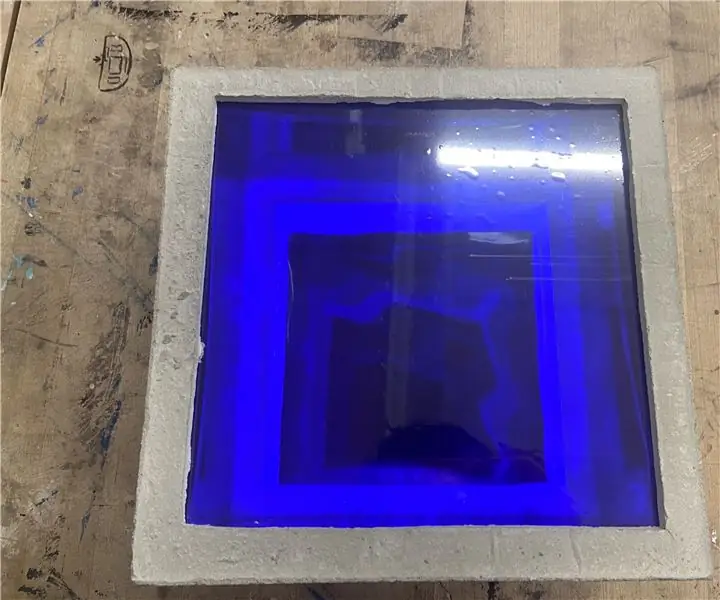
Table des matières:
- Auteur John Day [email protected].
- Public 2024-01-30 09:06.
- Dernière modifié 2025-01-23 14:45.

Il s'agit d'une œuvre d'art de dispositif d'éclairage LED pour mon projet de sculpture nommé Objet sacré. J'utilise cet appareil pour présenter une entrée pour un nouveau monde. Lorsque j'allume la lumière LED, nous pouvons voir un tunnel infini à l'intérieur de la boîte en béton. La bande LED est contrôlée via Bluetooth sur mon téléphone. J'ai acheté toutes les fournitures sur Amazon.
Matériaux:
-Arduino Uno
-Bande LED
-9v batterie
-DSD Tech SH-HC-08 Module esclave Bluetooth 4.0 BLE
-330 Ohms résistance
-iPhone
-Béton
-Acrylique
-Film pour vitre (miroir sans tain)
-Film miroir double face
Étape 1: conception de circuits
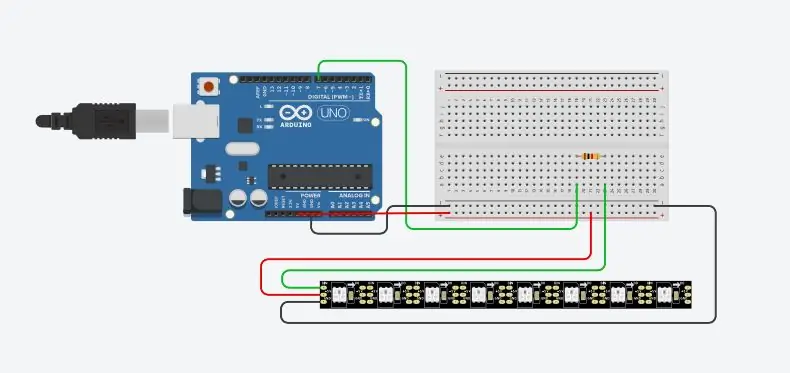

C'est ainsi que je fais fonctionner le circuit. J'ai également créé une séquence pour simuler un mouvement d'ondes cérébrales.
La première image est le circuit de bande LED.
La deuxième image est le circuit Bluetooth. L'application sur iPhone est BluetoothLED.
Étape 2: Code Arduino
#comprendre
#define LED_PIN 7 #define NUM_LEDS 60 LED CRGB[NUM_LEDS];
void setup() { pinMode(LED_PIN, OUTPUT); Serial.begin(9600); FastLED.addLeds(leds, NUM_LEDS); }
void setBlue(int val){ for (int i = 0; i< NUM_LEDS; i++) { leds = CRGB(0, 0, val); } FastLED.show(); } boucle vide() {
if(Serial.available()) { val = Serial.read(); } if(val == 'H'){ leds[0] = CRGB(0, 0, 0); FastLED.show(); led[1] = CRGB(0, 0, 0); FastLED.show(); leds[2] = CRGB(0, 0, 0); FastLED.show(); leds[3] = CRGB(0, 0, 0); FastLED.show(); led[4] = CRGB(0, 0, 0); FastLED.show();
led[5] = CRGB(0, 0, 0); FastLED.show();
led[6] = CRGB(0, 0, 0); FastLED.show();
led[7] = CRGB(0, 0, 0); FastLED.show();
led[8] = CRGB(0, 0, 0); FastLED.show();
leds[9] = CRGB(0, 0, 0); FastLED.show();
leds[10] = CRGB(0, 0, 0); FastLED.show();
leds[11] = CRGB(0, 0, 0); FastLED.show();
leds[12] = CRGB(0, 0, 0); FastLED.show();
leds[13] = CRGB(0, 0, 0); FastLED.show();
leds[14] = CRGB(0, 0, 0); FastLED.show();
leds[15] = CRGB(0, 0, 0); FastLED.show();
leds[16] = CRGB(0, 0, 0); FastLED.show();
leds[17] = CRGB(0, 0, 0); FastLED.show();
leds[18] = CRGB(0, 0, 0); FastLED.show();
leds[19] = CRGB(0, 0, 0); FastLED.show();
leds[20] = CRGB(0, 0, 0); FastLED.show();
leds[21] = CRGB(0, 0, 0); FastLED.show();
leds[22] = CRGB(0, 0, 0); FastLED.show();
leds[23] = CRGB(0, 0, 0); FastLED.show(); leds[24] = CRGB(0, 0, 0); FastLED.show();
leds[25] = CRGB(0, 0, 0); FastLED.show();
leds[26] = CRGB(0, 0, 0); FastLED.show();
leds[27] = CRGB(0, 0, 0); FastLED.show();
leds[28] = CRGB(0, 0, 0); FastLED.show();
leds[29] = CRGB(0, 0, 0); FastLED.show();
leds[30] = CRGB(0, 0, 0); FastLED.show(); leds[31] = CRGB(0, 0, 0); FastLED.show();
leds[32] = CRGB(0, 0, 0); FastLED.show();
leds[33] = CRGB(0, 0, 0); FastLED.show(); leds[34] = CRGB(0, 0, 0); FastLED.show();
leds[35] = CRGB(0, 0, 0); FastLED.show();
leds[36] = CRGB(0, 0, 0); FastLED.show();
leds[37] = CRGB(0, 0, 0); FastLED.show();
leds[38] = CRGB(0, 0, 0); FastLED.show();
leds[39] = CRGB(0, 0, 0); FastLED.show();
leds[40] = CRGB(0, 0, 0); FastLED.show();
leds[41] = CRGB(0, 0, 0); FastLED.show();
leds[42] = CRGB(0, 0, 0); FastLED.show();
leds[43] = CRGB(0, 0, 0); FastLED.show(); leds[44] = CRGB(0, 0, 0); FastLED.show();
leds[45] = CRGB(0, 0, 0); FastLED.show();
leds[46] = CRGB(0, 0, 0); FastLED.show();
leds[47] = CRGB(0, 0, 0); FastLED.show();
leds[48] = CRGB(0, 0, 0); FastLED.show();
leds[49] = CRGB(0, 0, 0); FastLED.show();
leds[50] = CRGB(0, 0, 0); FastLED.show();
leds[51] = CRGB(0, 0, 0); FastLED.show();
leds[52] = CRGB(0, 0, 0); FastLED.show();
leds[53] = CRGB(0, 0, 0); FastLED.show(); leds[54] = CRGB(0, 0, 0); FastLED.show();
leds[55] = CRGB(0, 0, 0); FastLED.show();
leds[56] = CRGB(0, 0, 0); FastLED.show();
leds[57] = CRGB(0, 0, 0); FastLED.show();
leds[58] = CRGB(0, 0, 0); FastLED.show();
leds[59] = CRGB(0, 0, 0); FastLED.show();
retard (100); } else { for (int i = 255; i > 0; i--) { setBlue(i); retard(10); } pour (int i = 0; i < 255; i++) { setBlue(i); retard(10); } } }
Étape 3: fabrication d'un conteneur
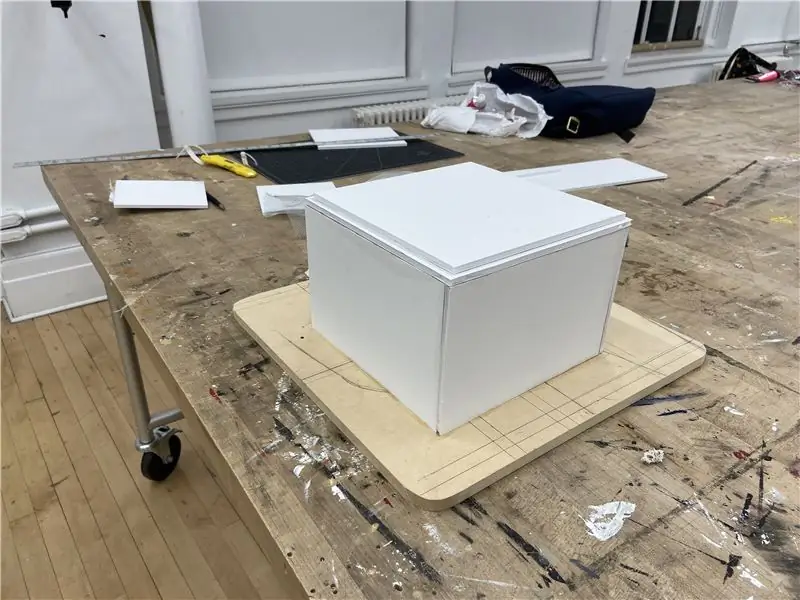
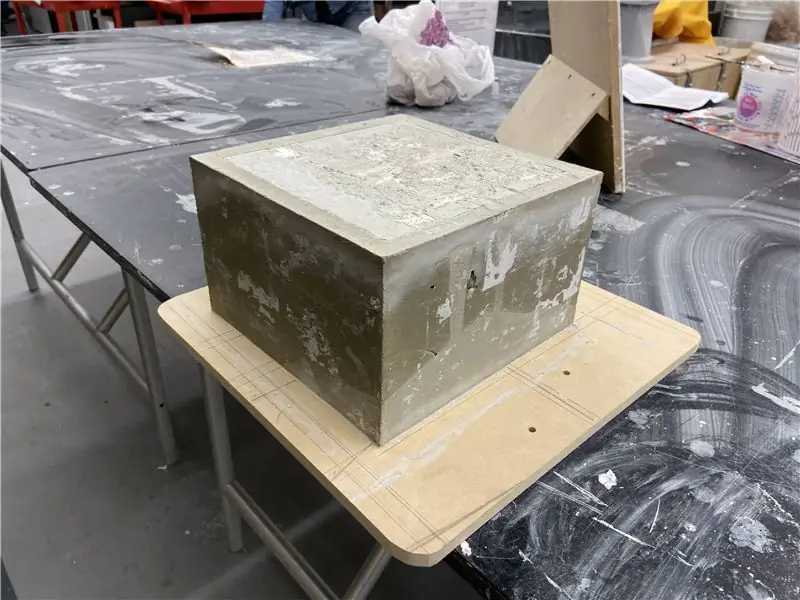
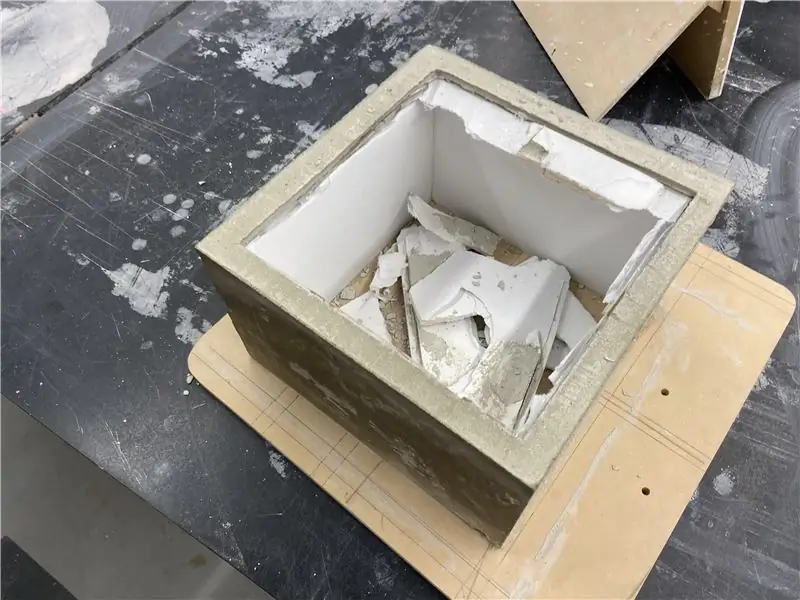
La boîte est en béton. J'utilise des panneaux de mousse pour faire une boîte creuse à couler avec du béton. Laissez sécher au moins 24 heures.
Étape 4: Découpe au laser
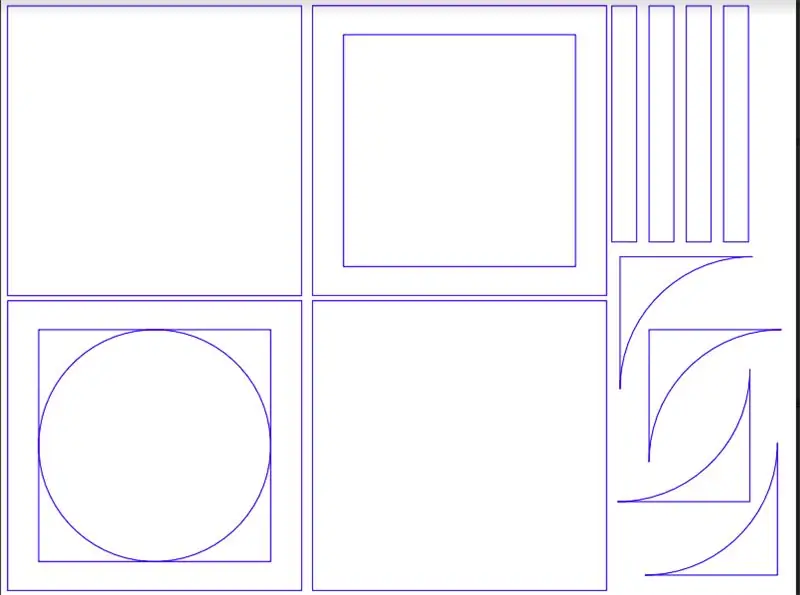
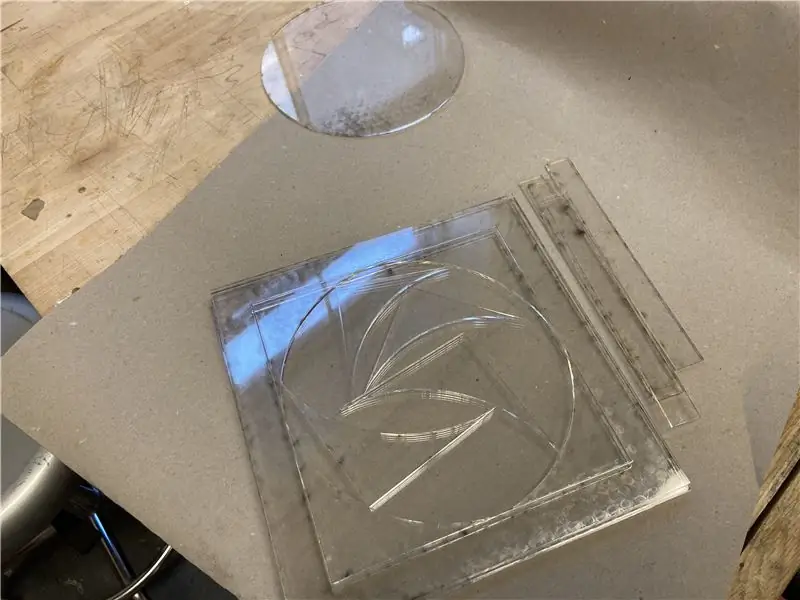
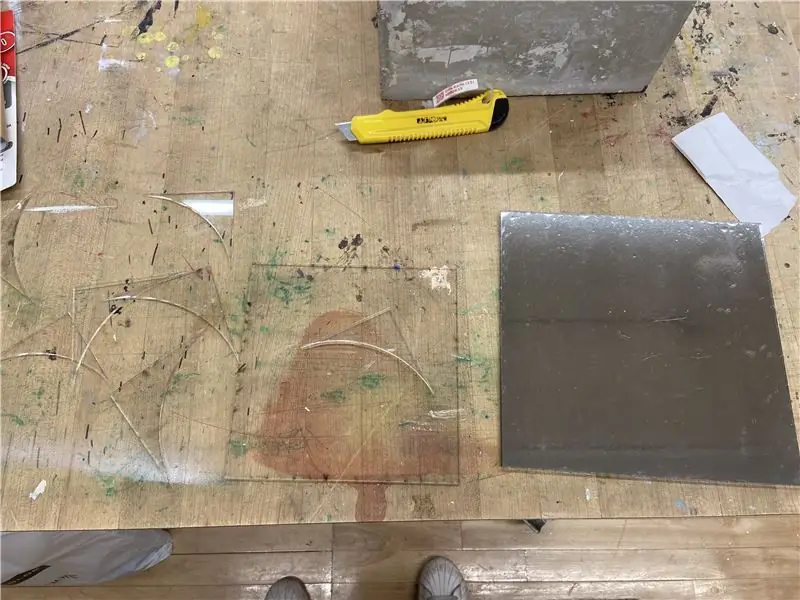
Dessiner la forme s'insère dans la boîte en béton et la découper avec la découpe laser.
Je l'utilise pour superposer différents espaces à l'intérieur de la boîte: l'espace de réflexion et l'espace de circuit. J'ai mis un film pour fenêtre miroir unidirectionnel et un film miroir double face sur les carrés acryliques chacun.
Étape 5: Bande LED
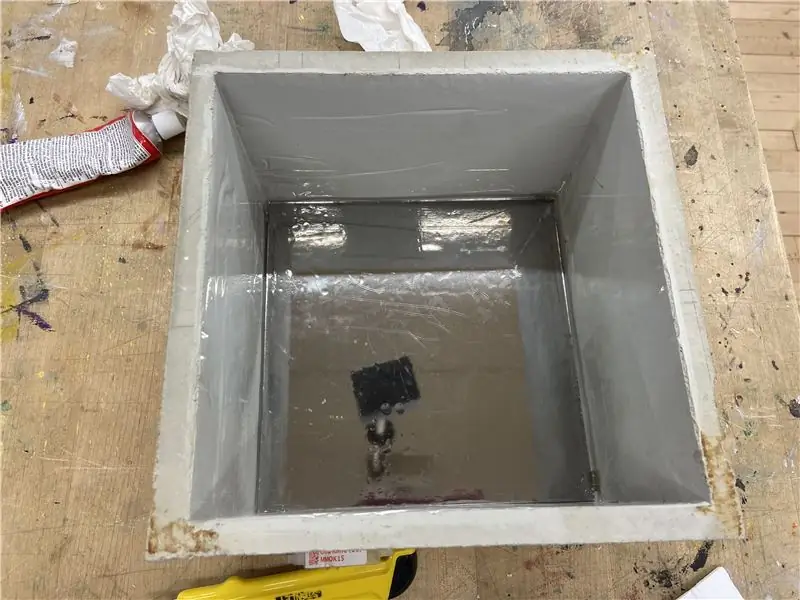
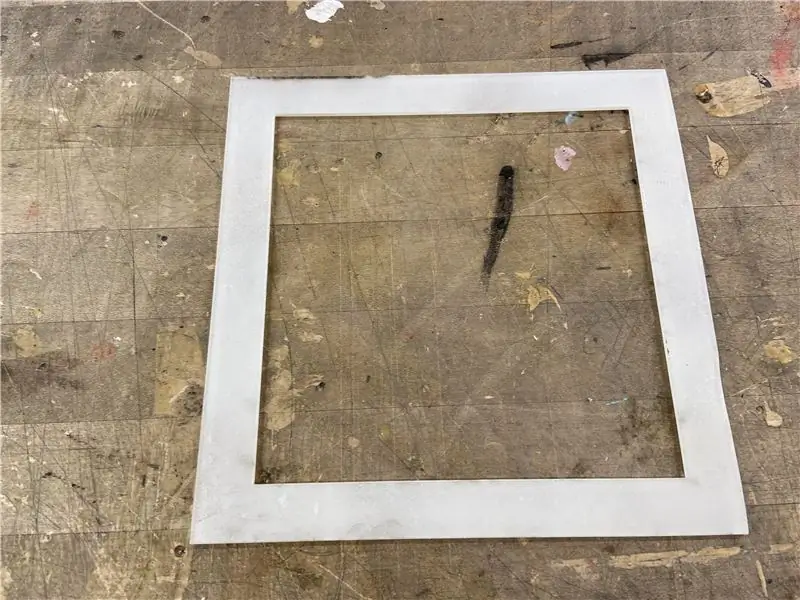
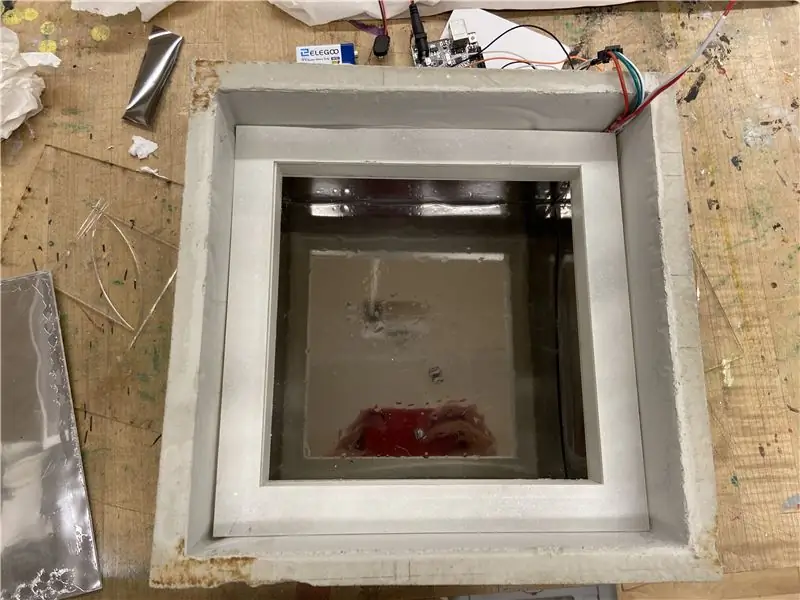
(Vue du bas de la boîte)
J'ai mis le film miroir unidirectionnel en premier, le côté miroir fait face à l'intérieur de la boîte. Et vaporisez de la couleur blanche sur le cadre pour créer un tube semi-transparent pour la bande LED et placez-le au milieu de la boîte.
Étape 6: Circuit
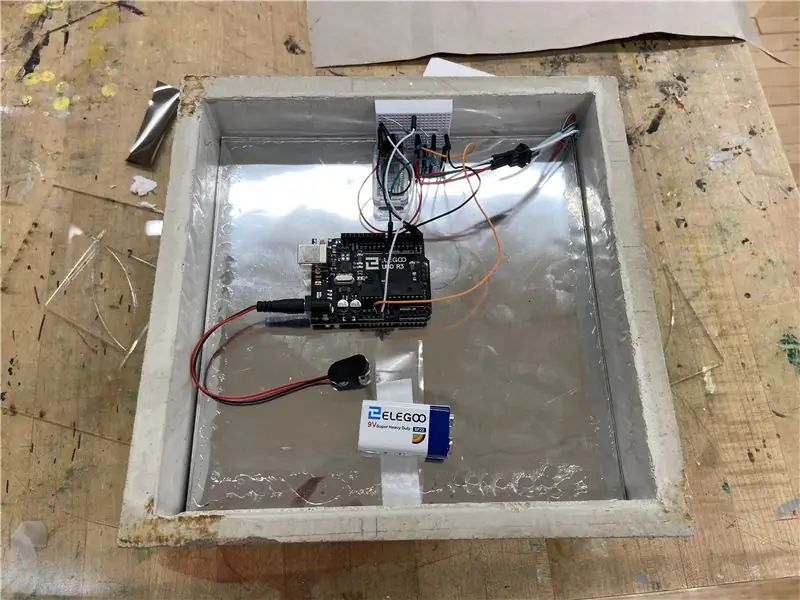
Mettez l'acrylique à double miroir latéral sur le dessus de la LED et fixez le circuit.
Conseillé:
Dispositif ASS (dispositif social antisocial) : 7 étapes
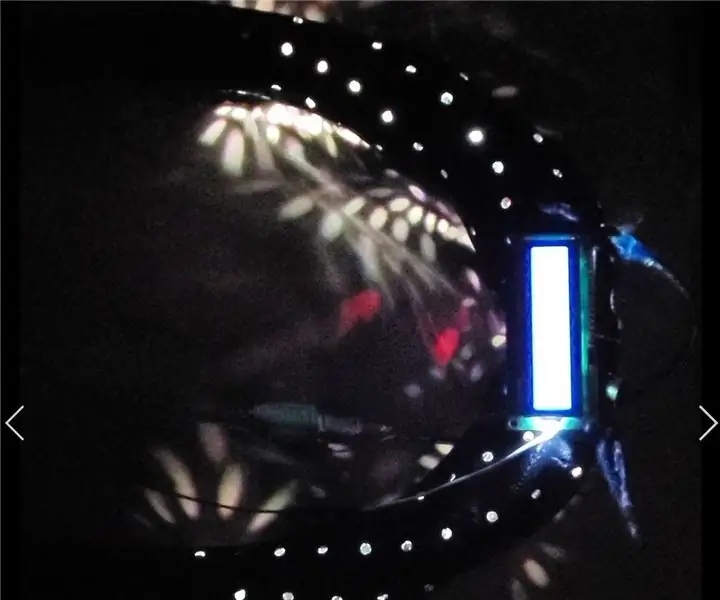
Dispositif ASS (dispositif social antisocial) : disons que vous êtes le genre de personne qui aime être avec les gens mais n'aime pas qu'ils s'approchent trop près. Vous aimez aussi les gens et avez du mal à dire non aux gens. Donc, vous ne savez pas comment leur dire de reculer. Eh bien, entrez - l'appareil ASS ! Oui
Cultiver plus de laitue dans moins d'espace ou Cultiver de la laitue dans l'espace (plus ou moins) : 10 étapes

Cultiver plus de laitue dans moins d'espace ou… Cultiver de la laitue dans l'espace (plus ou moins) : il s'agit d'une soumission professionnelle au concours Growing Beyond Earth, Maker, soumise via Instructables. Je ne pourrais pas être plus excité de concevoir pour la production de cultures spatiales et de publier mon premier Instructable. Pour commencer, le concours nous a demandé de
Encore une autre instruction sur l'utilisation du DIYMall RFID-RC522 et du Nokia LCD5110 avec un Arduino : 8 étapes (avec photos)
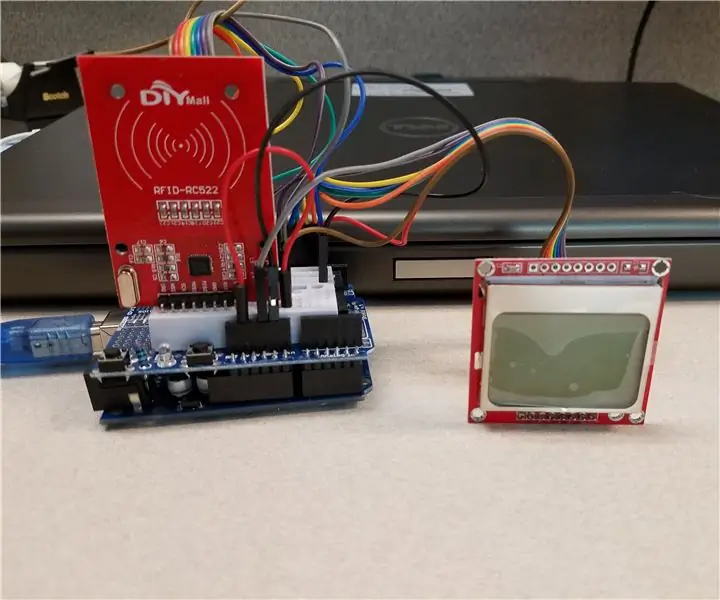
Encore un autre instructable sur l'utilisation du DIYMall RFID-RC522 et du Nokia LCD5110 avec un Arduino : Pourquoi ai-je ressenti le besoin de créer un autre Instructable pour le DIYMall RFID-RC522 et le Nokia LCD5110 ? Eh bien, pour vous dire la vérité, je travaillais sur une preuve de concept l'année dernière en utilisant ces deux appareils et en quelque sorte "mal placé"
Comment émuler une télécommande TV ou autre avec Arduino Irlib : 3 étapes (avec photos)
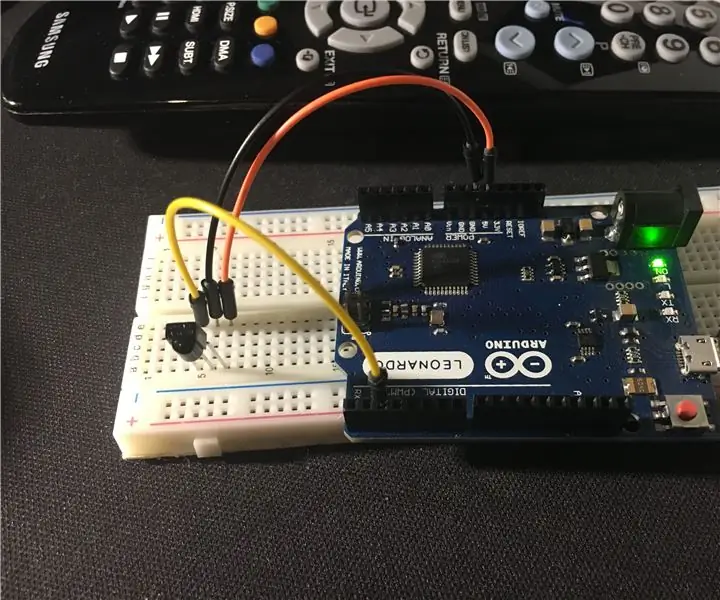
Comment émuler une télécommande TV ou autre avec Arduino Irlib: IntroductionSalut à tous et bienvenue dans mon premier Instructable.Aujourd'hui, nous allons apprendre, comme le titre l'indique, à émuler une télécommande TV ou quelque chose de similaire qui fonctionne avec les signaux infrarouges en utilisant Arduino (n'importe quel modèle) .Le problème était : Comment puis-je transmettre des codes à un
Boîte à lumière pliable pour ceux qui manquent d'espace et d'argent : 12 étapes (avec photos)

Boîte à lumière pliable pour ceux qui manquent d'espace et d'argent : j'ai décidé de relever le défi de créer une boîte à lumière pliable et abordable pour les personnes qui manquent d'espace et d'argent. Le problème que j'ai trouvé avec la plupart des caissons lumineux à noyau de mousse abordables est que chaque fois que vous voulez le prendre, faites-le
